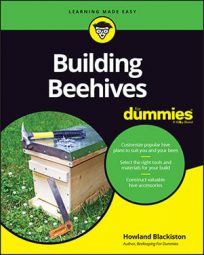Using a screened bottom-board in a hive offers the great advantage of improved ventilation. Poor ventilation is one of the leading causes of stress on a bee colony. A screened bottom-board (sans the inspection board) provides the ultimate in ventilation. Some beekeepers leave the screened bottom-board on the colony all year long, even in cold winter climates.
Assemble the "floor."
Place the two long sides and the front and rear sides flat on your work surface. Essentially, you're assembling a square donut. You don't need to nail or glue anything yet.
Attach the side rails and the back cleat to the floor.
Take the two side rails and insert the "floor" assembly into the dado cut of each rail.
Be certain that the dado faces the same way in all rails (the dado isn't centered along the rail). Otherwise, you'll have a seriously lopsided bottom-board!
Place one of the deck screws halfway into the center of each of the two side rails (the screws go through the rails and into the edges of the floor assembly). Don't screw them all the way in quite yet. First make sure everything fits properly and is square — you won't have room for adjustment after all the screws are in!
When the fit looks good, use four additional deck screws spaced evenly (by eye) along each long rail. Use the first figure in the earlier section "Cut List" as a visual guide for placing the screws. These screws hold that square donut together!
The screws will go in easier if you first drill a 7/64-inch hole in each spot you plan to place a screw. The pre-drilling also helps prevent the wood from splitting.
Consider using weatherproof wood glue in addition to the deck screws. It helps make the bottom-board as strong as possible. Apply a thin coat of glue wherever the wooden parts are joined together.
Nail the rear cleat to the floor assembly, using four evenly spaced flat-head, diamond-point wire nails.
Toe-nail the floor.
Turn the floor over and toe-nail its four sides for additional strength. One nail placed in each corner will do fine.
Attach the screening material.
Attach the #8 hardware cloth to the top of the "opening" of the bottom-board. Use 3/8 inch staples spaced approximately 2 inches apart. Staples go around the entire perimeter of the screening. Just make sure that there are no gaps where the bees could squeeze through.
Add the nylon twine to the bottom of the assembly.
Staple the 2-ply nylon twine to the underside of the bottom-board with a staple gun, using a zigzag pattern, as shown in the preceding figure. Keep the twine as taut as possible. The twine holds the removable inspection board in place.
Nylon twine has a propensity to unravel. Prevent this by singeing the cut ends of the twine with a flame.
Slide the inspection board into the assembly.
Turn the bottom-board right-side-up and slide the inspection board (the Plasticor corrugated art board) into place under the screened area with the twine mesh holding it in place.
Many beekeepers (me included) put a thin coating of petroleum jelly on the top surface of the inspection board. This provides a sticky surface that ensures that any mites that fall on the board remain where they fall (like flypaper). Just wipe it off and reapply after each inspection.
Place your hive on the screened bottom-board.
The screened bottom-board replaces a standard bottom-board. With your screened bottom-board on the ground or on your hive stand (the ideal option), simply sit your Langstroth hive right on top of the screened bottom-board, as shown in the following figure.
Don't paint the parts of the screened bottom-board that are inside the hive. However, if you paint, stain, varnish, or polyurethane your hives, you're welcome to do the same to the edges of the bottom-board — that is, those sides that are seen from the outside. This provides some protection from the elements and certainly helps the screened bottom-board visually blend in with the rest of your hive.
![[Credit: Illustration by Felix Freudzon, Freudzon Design]](https://www.dummies.com/wp-content/uploads/357127.image0.jpg) Credit: Illustration by Felix Freudzon, Freudzon Design
Credit: Illustration by Felix Freudzon, Freudzon Design

